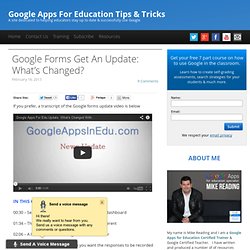

Google Forms Get An Update: What's Changed? - Google Apps For Education Tips & Tricks. If you prefer, a transcript of the Google forms update video is below 00:30 – Select the rapid lease option in your Apps dashboard 01:34 – The Google Forms layout is completely different 02:06 – A look at what has changed with the toolbar 02:10 – You can now choose where you want the responses to be recorded 02:50 – How to view the live form 03:00 – The send form button has changed 03:30 – We can now customise the confirmation page!

03:55 – Allow participants to submit another response? 04:25 – Allow the participant to edit the response? 05:08 – Show a summary of previous responses? 06:00 – You can paste in dot points from a Doc to form multiple choice answers 06:57 – Get a pre-filled URL 08:07 – How to unlink a form Hi I’m Mike Reading from GoogleAppsInEdu.com and today I’m going to show you some of the new features that’s been released by Google forms. So today we are dealing with Google forms so we’re just going to create a form. You will notice that the toolbar up here looks different. The Importance of Daily Data Collection in Special Education « Developing Minds Software News. How should individuals working with special education students determine what goals are appropriate for a specific child and whether the child is making more than “trivial progress” towards those goals?

The answer is: using data. The use of data collection and analysis procedures to monitor the academic, social, and behavior progress of children with special needs has long been recognized as a necessary component of special education and therapy programs. Data is necessary to measure the effectiveness of new intervention strategies: a new diet or medication, an applied behavioral analysis (ABA) program, speech therapy or occupational therapy. Data allows us to monitor a child’s progress as we implement different interventions and adjust the way the interventions are delivered based on the progress data. 4 Tips for IEP Goal Data Collection.
The first trimester of our school year is ending, so I’m gearing up to write and send home IEP goal progress monitoring summaries for all of my students.

This requires reviewing student work samples, notes, and data that has been collected by paraeducators, the classroom teacher, and myself and synthesizing it into a meaningful statement of progress toward achieving each goal written in the IEP. For example, “Jenny is able to read 15 out of 20 first grade sight words when given in words lists and leveled readers.” In addition to reflecting on my students’ success for the first part of the year, I also take time to think about what is and is not working with our data collection system. Over the past few years, I find I keep identifying the same components as critical for meaningful IEP goal data collection: 1) Simple data collection forms. 2) Provide training on how and when to collect data. 3) Everyone collects data. 4) Use the data. A tutorial for therapists and educators. Data collection isn't the most fun topic.

Before iPads, my folders for kids were full of sticky notes, therapy data forms, attendance forms, and other assorted loose items. At progress report time, I would try to study my hand-written data for trends, and come up with some percentages to show growth, or lack of growth. For children with multiple goals, or those with collaborative goals, consistent data collection was even more challenging! I have recently updated this to reflect the changes that Google has made in making forms (6/15/13).
Enter Google Forms and Spreadsheets!!! Step 1---go to Google Drive (you must have a Gmail account). Google Forms and Spreadsheets. Data and information collecting isn't the most glamorous subject; however, with the influx of iPads into my school setting, and the increasing popularity of Google spreadsheets and forms, data collection has become a hot topic among the SLPs in our school system!

Several of us have embraced using Google forms and spreadsheets to make our data collecting lives border on fun. Before Google, my folders for kids were full of sticky notes, therapy data forms, attendance forms, and other assorted loose items. Now, progress report time is cleaner and more data oriented, because much of what I need has been systematically collected by Google forms into the spreadsheets. (There is a spreadsheet for every form.) This is a brief description of various ways I currently use the forms and spreadsheets in practice. 1. For each of my students, I have created a Google form based on the student's IEP goals and objectives. 4. 5.
For a tutorial on creating your own forms, go to this page. Make It Work: Dominate Your IEP Data.